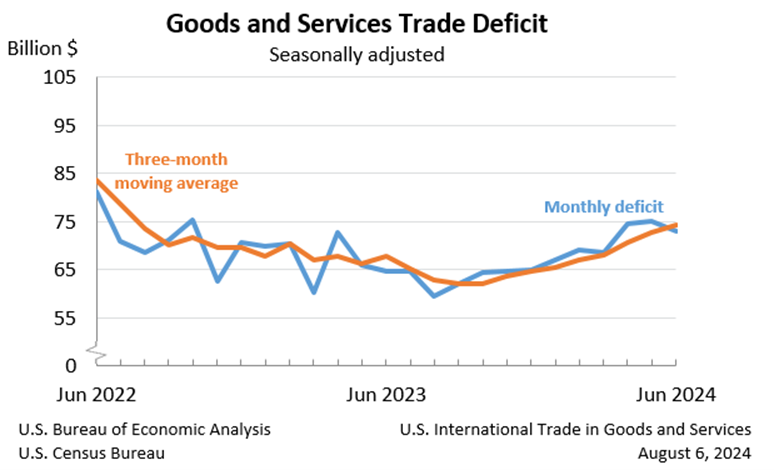EBRC Research Staff
Current data releases as of 9 August 2024
Based on a recent Census Bureau release, there were 28.5 million nonemployer businesses in the nation in 2021. These are businesses without paid employees. Women owned 42.1% of the nonemployer businesses in the U.S. Arizona compares well in that 43.1% of nonemployer businesses in the state are women-owned. Arizona had a larger percentage of Hispanic-owned nonemployer firms at 23.5% than the U.S., at 16.6%. There was also a larger share of veteran-owned businesses in Arizona compared to the nation, at 5.9% and 4.6%, respectively. — Valorie Rice
Phoenix housing prices were up 4.4% over the year in May. All 20 cities in the index have continued price gains since December 2023, according to the S&P CoreLogic Case-Shiller release from July 30. New York had the highest year-over-year increase at 9.4% replacing San Diego at 9.1%, which had the top spot for several months. Portland with a 1.0% gain had the lowest change for the second month in row. Nationally, house prices were up 5.9% in May compared to 6.4% in April. The 20-city composite reported a 6.8% increase for May. All 20 cities and the nation had monthly gains for April and May. — Valorie Rice
The June goods and services trade deficit came in at $73.1 billion, down $1.9 billion from a revised $75.0 billion in May. June exports rose $3.9 billion to $265.9 billion, and imports similarly rose $2.0 billion to $339.0 billion. The decrease in the deficit reflects a decrease in the goods deficit of $2.5 billion to $97.4 billion and a decrease in the services surplus of $0.6 billion to $24.2 billion. Over the year, the goods and services deficit increased $22.7 billion, or 5.6%, with exports rising 3.8% and imports increasing 4.2%. The largest surpluses, in billions, occurred with Netherlands ($4.8), South and Central America ($3.6), and Hong Kong ($2.1), while the greatest deficits were with China ($22.3), European Union ($18.0), and Mexico ($13.7). –Delaney O’Kray-Murphy
The U.S. unemployment rate rose to 4.3% in July and total nonfarm payroll employment increased by 114,000, according to the Bureau of Labor Statistics August 2nd employment summary. Among the major worker groups, the unemployment rates for adult men (4.0%) and whites (3.8%) increased in July, while the other groups saw little or no change. Total nonfarm payroll employment increased below the average monthly gain of 215,000 over the past 12 months. Employment trended up in health care (+55,000), construction (+25,000), and transportation and warehousing (+14,000). Information lost jobs (-20,000). This release also revised both May and June numbers for a total decrease in employment of -29,000. –Delaney O’Kray-Murphy
In June, over the year metropolitan unemployment rates were higher in 336 of the 389 metropolitan areas, lower in 40, and unchanged in the remaining 13. The June unemployment rate for the Tucson and Phoenix metropolitan areas came in at 3.9% and 3.5%, respectively. Yuma had the highest unemployment rate in Arizona at 12.7%, while Phoenix had the lowest. Burlington-South Burlington, VT, and Sioux Falls, SD, had the lowest unemployment rates, 1.9% each. El Centro, CA, had the highest rate, 16.4%. The largest over-the-year increase occurred in Toledo, OH with a 1.8 percentage point increase, while Yuma, AZ, had the largest over-the-year decrease with -1.3 percentage points. –Delaney O’Kray-Murphy
During the second quarter of 2024, Phoenix had a 3.3% 12-month increase in the Employment Cost Index (ECI) for private industry workers, compared to the previous quarter’s 12-month change of 2.7%. In this same period, the national average for total compensation growth stood at 4.1%, placing Phoenix’s ECI below the U.S. average. Miami-Fort Lauderdale-Port St. Lucie, FL MSA exhibited the largest change in total compensation with an increase of 5.6%. The only metropolitan areas with more restrained compensation growth than Phoenix in the second quarter of 2024 were Boston-Worchester-Providence at 3.1% and Philadelphia-Reading-Camden at 3.2%. — Valorie Rice
The June 2024 release of the Job Openings and Labor Turnover (JOLTS) report stated the number of job openings in the U.S. remained at 8.2 million, while the job openings rate was 4.9%. The industry with the largest increase was accommodation and food services (+120,000). The industry that saw the largest decrease was in durable goods manufacturing (-88,000). The number of hires was 5.3 million, with a rate of 3.4% for June, little changed from the prior months at 3.6% for May, and 3.5% for April. The number of total separations in the nation was 5.1 million, with a rate of 3.2%. The number of quits indicated 3.3 million with a rate of 2.1%, while the number of layoffs and discharges was 1.5 million with a rate of 0.9%. –Alex Jaeger






